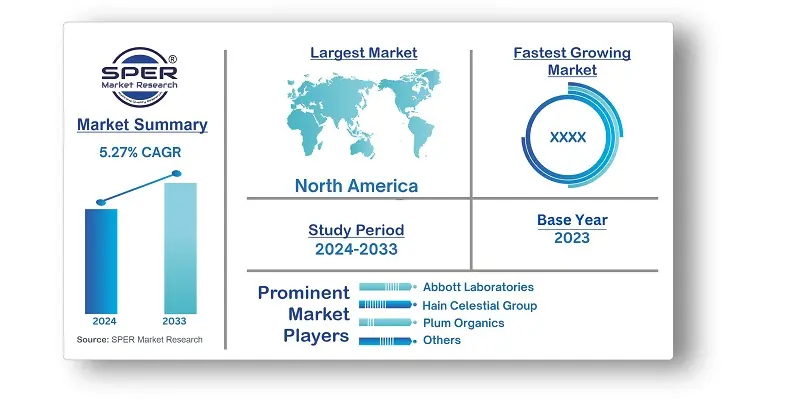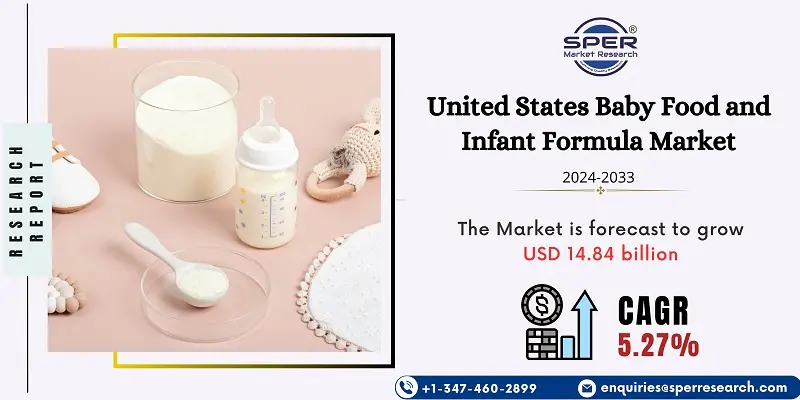
US Baby Food and Infant Formula Market Trends, Share, Demand, Revenue and Future Outlook
United States Baby Food and Infant Formula Market Growth, Size, Trends Analysis- By Type, By Packaging Type, By Distribution Channel- Regional Outlook, Competitive Strategies and Segment Forecast to 2033
| Published: Oct-2024 | Report ID: FOOD24113 | Pages: 1 - 103 | Formats*: |
| Category : Food & Beverages | |||
- May 2023; Alpha-lactalbumin (alpha) is abundant in Lacprodan Alpha-50, a component in infant formula introduced by Arla Foods Ingredients. This ground-breaking release was especially designed to meet the growing need for lower protein formulas.
- February 2020; Happy Baby Regenerative Organic and Organic Baby Food are the two new product categories that Happy Family Organics has released. Growing regenerative agricultural exercises are included in a new line of products for babies.


| Report Metric | Details |
| Market size available for years | 2020-2033 |
| Base year considered | 2023 |
| Forecast period | 2024-2033 |
| Segments covered | By Type, By Packaging Type, By Distribution Channel |
| Regions covered | Eastern Region, Western Region, Southern Region, Northern Region |
| Companies Covered | Abbott Laboratories, Beech-Nut Nutrition, Earth’s Best Organic, Gerber Products Company, Happy Family, Hain Celestial Group, Mead Johnson Nutrition, Nestlé, Plum Organics, and Similac. |
- New Parents
- Expecting Parents
- Caregivers
- Health Professionals (Pediatricians, Nutritionists)
- Childcare Centers
- Retailers (Supermarkets, Online Stores)
- Families with Infants and Toddlers
- Parents Seeking Organic/Natural Products
- Parents of Allergic Children
| By Type: | |
| By Packaging Type: | |
| By Distribution Channel: |
- United States Baby Food and Infant Formula Market Size (FY’2024-FY’2033)
- Overview of United States Baby Food and Infant Formula Market
- Segmentation of United States Baby Food and Infant Formula Market By Type (Anterior Infant Formula, Baby Food and Others)
- Segmentation of United States Baby Food and Infant Formula Market By Packaging Type (Bottles, Cans, Pouches And Others)
- Segmentation of United States Baby Food and Infant Formula Market by Distribution Channel (Store-Based and Non-Store-Based)
- Statistical Snap of United States Baby Food and Infant Formula Market
- Expansion Analysis of United States Baby Food and Infant Formula Market
- Problems and Obstacles in United States Baby Food and Infant Formula Market
- Competitive Landscape in the United States Baby Food and Infant Formula Market
- Impact of COVID-19 and Demonetization on United States Baby Food and Infant Formula Market
- Details on Current Investment in United States Baby Food and Infant Formula Market
- Competitive Analysis of United States Baby Food and Infant Formula Market
- Prominent Players in the United States Baby Food and Infant Formula Market
- SWOT Analysis of United States Baby Food and Infant Formula Market
- United States Baby Food and Infant Formula Market Future Outlook and Projections (FY’2024-FY’2033)
- Recommendations from Analyst
1.1. Scope of the report1.2. Market segment analysis
2.1. Research data source
2.1.1. Secondary Data2.1.2. Primary Data2.1.3. SPER’s internal database2.1.4. Premium insight from KOL’s
2.2. Market size estimation
2.2.1. Top-down and Bottom-up approach
2.3. Data triangulation
4.1. Driver, Restraint, Opportunity and Challenges analysis
4.1.1. Drivers4.1.2. Restraints4.1.3. Opportunities4.1.4. Challenges
4.2. COVID-19 Impacts of the United States Baby Food and Infant Formula Market.
5.1. SWOT Analysis
5.1.1. Strengths5.1.2. Weaknesses5.1.3. Opportunities5.1.4. Threats
5.2. PESTEL Analysis
5.2.1. Political Landscape5.2.2. Economic Landscape5.2.3. Social Landscape5.2.4. Technological Landscape5.2.5. Environmental Landscape5.2.6. Legal Landscape
5.3. PORTER’s Five Forces
5.3.1. Bargaining power of suppliers5.3.2. Bargaining power of buyers5.3.3. Threat of Substitute5.3.4. Threat of new entrant5.3.5. Competitive rivalry
5.4. Heat Map Analysis
6.1. United States Baby Food and Infant Formula Market Manufacturing Base Distribution, Sales Area, Product Type6.2. Mergers & Acquisitions, Partnerships, Product Launch, and Collaboration in United States Baby Food and Infant Formula Market
7.1. United States Baby Food and Infant Formula Market Size, Share and Forecast, By Type, 2020-20267.2. United States Baby Food and Infant Formula Market Size, Share and Forecast, By Type, 2027-20337.3. Anterior Infant Formula7.4. Baby Food7.5. Others
8.1. United States Baby Food and Infant Formula Market Size, Share and Forecast, By Packaging Type, 2020-20268.2. United States Baby Food and Infant Formula Market Size, Share and Forecast, By Packaging Type, 2027-20338.3. Bottles8.4. Cans8.5. Pouches8.6. Others
9.1. United States Baby Food and Infant Formula Market Size, Share and Forecast, By Distribution Channel, 2020-20269.2. United States Baby Food and Infant Formula Market Size, Share and Forecast, By Distribution Channel, 2027-20339.3. Store-Based9.4. Non-Store-Based
10.1. United States Baby Food and Infant Formula Market Size and Market Share
11.1. United States Baby Food and Infant Formula Market Size and Market Share By Region (2020-2026)11.2. United States Baby Food and Infant Formula Market Size and Market Share By Region (2027-2033)11.3. United States11.4. Eastern Region11.5. Western Region11.6. Southern Region11.7. Northern Region
12.1. Abbott Laboratories
12.1.1. Company details12.1.2. Financial outlook12.1.3. Product summary12.1.4. Recent developments
12.2. Beech-Nut Nutrition
12.2.1. Company details12.2.2. Financial outlook12.2.3. Product summary12.2 .4. Recent developments
12.3. Earth’s Best Organic (Hain Celestial)
12.3.1. Company details12.3.2. Financial outlook12.3.3. Product summary12.3.4. Recent developments
12.4. Gerber Products Company (Nestlé)
12.4.1. Company details12.4.2. Financial outlook12.4.3. Product summary12.4.4. Recent developments
12.5. Happy Family (NextFoods)
12.5.1. Company details12.5.2. Financial outlook12.5.3. Product summary12.5.4. Recent developments
12.6. Hain Celestial Group
12.6.1. Company details12.6.2. Financial outlook12.6.3. Product summary12.6.4. Recent developments
12.7. Mead Johnson Nutrition (Reckitt Benckiser)
12.7.1. Company details12.7.2. Financial outlook12.7.3. Product summary12.7.4. Recent developments
12.8. Nestlé
12.8.1. Company details12.8.2. Financial outlook12.8.3. Product summary12.8.4. Recent developments
12.9. Plum Organics
12.9.1. Company details12.9.2. Financial outlook12.9.3. Product summary12.9.4. Recent developments
12.10. Others
SPER Market Research’s methodology uses great emphasis on primary research to ensure that the market intelligence insights are up to date, reliable and accurate. Primary interviews are done with players involved in each phase of a supply chain to analyze the market forecasting. The secondary research method is used to help you fully understand how the future markets and the spending patterns look likes.
The report is based on in-depth qualitative and quantitative analysis of the Product Market. The quantitative analysis involves the application of various projection and sampling techniques. The qualitative analysis involves primary interviews, surveys, and vendor briefings. The data gathered as a result of these processes are validated through experts opinion. Our research methodology entails an ideal mixture of primary and secondary initiatives.



Frequently Asked Questions About This Report
PLACE AN ORDER
Year End Discount
Sample Report
Pre-Purchase Inquiry
NEED CUSTOMIZATION?
Request CustomizationCALL OR EMAIL US
100% Secure Payment






Related Reports
Our Global Clients
Our data-driven insights have influenced the strategy of 200+ reputed companies across the globe.




















